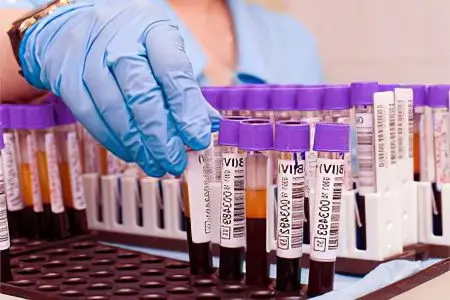Contents
What does an AST blood test mean?

AST, AST, AST or aspartate aminotransferase is the same concept, denoting one of the enzymes of protein metabolism in the body. This enzyme is responsible for the synthesis of amino acids that make up cell membranes and tissues. Not in all organs AST shows its activity. Moreover, this type of aminotransferases can be attributed to specific enzymes, the excess activity of which indicates a rather narrow range of pathological conditions. Most of all, AST is found in the myocardium (heart muscle), hepatocytes (liver tissue), brain neurons, and skeletal muscle tissue. This is explained by a rather high level of metabolic processes in them and the need for maximum adaptability of cells to maintain their structure. This enzyme helps them in this.
As long as the structure of cells containing AST is not disturbed, the amount of this enzyme in plasma is minimal and does not go beyond the normal range. As soon as their integrity is violated, this leads to its excessive release into the systemic circulation. Such a phenomenon will be recorded in the form of a regular increase in AST activity. The dependence should be directly proportional: the more active the cytolysis, the higher the level of AST. Important is the time after the onset of cell destruction – the longer it is, the less the enzyme activity in plasma will be.
When prescribing a biochemical blood test, they imply an analysis of the enzymatic activity of the plasma, among other indicators of which AST is necessarily examined. This requires venous blood, which is obtained by puncturing one of the peripheral veins in the amount of 15-20 milliliters. Its centrifugation allows you to separate the plasma from the formed elements, which then lends itself to various chemical reactions. In their course, the activity of AST in the blood is determined.
When is an AST analysis scheduled?

According to international protocols and standards for diagnosing diseases, a biochemical blood test, including an indicator of AST activity, is mandatory for many types of somatic pathology.
It can be:
Acute and chronic diseases of the heart and circulatory system;
Any pathology of the liver;
Poisoning and intoxication;
Kidney damage with renal insufficiency;
Infectious pathology;
Purulent-septic conditions;
Various kinds of jaundice and disorders of bilirubin metabolism;
Signs of ascites and portal hypertension;
Encephalopathy of unknown origin;
Autoimmune diseases;
Acute pathology of the abdominal organs of a surgical nature;
Any form of cholelithiasis and disorders of bile outflow;
Pancreatic necrosis and chronic pancreatitis;
Endocrine pathology;
Allergic skin diseases;
Malignant tumors of any localization and suspicion of their metastasis;
Aggressive and prolonged treatment with chemotherapy drugs, antibiotics and other toxic drugs;
Preoperative preparation for any complex interventions;
Evaluation of the dynamics and effectiveness of the treatment of liver and heart diseases;
Injuries to the chest and abdomen with suspected contusion of the heart or liver;
The rate of AST in the blood
In order to correctly evaluate the obtained indicators of plasma enzymatic activity in relation to AST, you need to know its normal values. Most laboratories usually indicate the rate next to the obtained indicator. This is due to the fact that different reagents and methods can be used to determine the AST index. The types and standards given in the table are considered generally accepted.
method for determination | Norm for men | Norm for women | Norm for children |
Optical (in IU) | Until 40-41 ME | Until 34-35 ME | Up to 50 ME |
Reitman-Frenkel reactions (in µmol/(h/ml)) | 0,1-0,45 | 0,1-0,35 | 0,2-0,5 |
Reasons for increasing AST

Detection of an increase in the AST index, especially repeated, may indicate such diseases:
Acute myocardial infarction in the initial phases of its development. According to the dynamics of the indicator, one can judge its vastness and the recovery period;
Closed and open heart injuries;
Myocarditis of autoimmune or infectious origin;
Acute and chronic viral hepatitis;
Toxic lesions of the liver with hepatotoxic poisons and drugs;
Fatty and alcoholic hepatosis;
Endogenous intoxications against the background of infectious and purulent-septic diseases of internal organs and soft tissues;
Severe chronic heart failure;
Cholestasis caused by a mechanical obstruction in the bile ducts (stones, tumors, congenital anomalies);
Violation of hepatic blood flow and portal hypertension;
Cirrhosis of the liver with preservation of intact areas of this organ. In decompensated cirrhosis, the enzymatic activity of plasma against AST decreases due to the complete replacement of the liver with connective tissue;
Metastases in the liver of malignant tumors;
Primary cancer of the liver or bile ducts;
Damage to the liver and heart in malignant forms of myeloid leukemia;
Massive destruction of muscle tissue (myodystrophy, generalized myositis, crush syndrome, reperfusion syndrome against the background of restored blood flow in the ischemic limb;
Not every increase in AST should be taken as a sign of cellular cytolysis. If the indicator is higher than normal values by several units of measurement, this still does not mean anything. Diagnostic value has an increase in AST two or more times higher than normal.
In this regard, we can talk about:
Moderate increase (when AsAT rises five times);
Average increase (when an increase in the indicator up to ten times higher than the norm is recorded);
Severe increase (exceeding the level of AST ten or more times compared to the norm).
How to lower AST in the blood?
Since this symptom signals the destruction of cells containing this enzyme (heart, liver, muscles), it is necessary to diagnose and treat diseases of these organs. Only healthy tissues will be able to function normally and normalize all indicators of a biochemical blood test, including AST.
It must be clearly understood that an increase in AST is not the cause of the disease. This is her consequence. Therefore, only the elimination of the causative disease can interrupt the causal relationship, which will be reflected in the form of normalization of AST activity and will become a criterion for victory over this disease. Any cases of increased aspartate aminotransferase are a reason for seeking specialized medical care. Behind this harmless and asymptomatic sign, severe chronic diseases are often hidden, which will manifest themselves only after a while.









